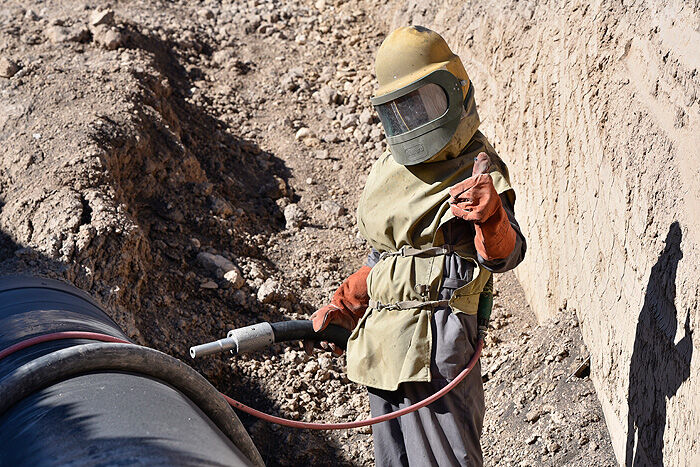Mehdi Jamshidi Dana, CEO of Iranian Gas Transmission Company (IGTC), said recently Iran’s gas transmission capacity had reached 870 mcm/d. During the first five months of the current calendar year, sweet gas transmission in Iran grew 12% year-on-year.
Iran’s current gas production capacity stands at 880 mcm/d, which is forecast to reach 1,000 mcm/d by March 2021. The domestic gas consumption varies between 550 mcm/d and 750 mcm/d.For the distribution of such big volume of gas to domestic and industrial consumers, long gas pipelines have been built in recent years. That is why gas transmission from production to consumption centers has been under way without any halt.
A total of 86 gas compressors along with 316 turbocompressors are installed on a 37,400-km-long high-pressure gas transmission pipeline in order to carry gas to consumers. All of these turbocompressors are not operating; however, in wintertime, maximum gas transmission may require the operation of all turbocompressors in addition to activating spare turbines.
Jamshidi-Dana has said that the 316 turbines serving gas transmission was equivalent to 75% of Iran’s aviation fleet.
The operational phases of the South Pars gas field in the past seven years have brought production capacity in the giant offshore South Pars field to 700 mcm/d from 280 mcm/d in recent years. As a result, the gas distribution network in Iran has expanded and Iran’s dependence on Turkmen gas imports in the winter has ended without causing any halt in national gas distribution.
According to IGTC officials, the company has managed to raise the gas transmission stability to 100 percent in recent years, even registering good records in the gas transmission. For instance, on a single day last February, 816 mcm/d of sweet gas was distributed.
Jamshidi-Dana said the operation of the Iran Gas Trunkline 9 (IGAT-9) in the current calendar year would add another 50 mcm/d to the aforesaid amount.
Gas Transmission Capacity
In September, 99,850 km of IGAT-6 and IGAT-9 along with five gas compressors became operational. Inauguration of the projects would stabilize gas transmission and add 110 mcm/d to the gas transmission capacity.
Furthermore, the South Pars gas production capacity would increase this year, which would require new transmission lines to carry gas to consumers. Therefore, in parallel with planning to raise gas production, the gas transmission network should have enough capacity.
“The current gas transmission capacity is good because the gas produced at South Pars would not increase any further. We forecast another 50 mcm/d gas production, but IGAT-9 would also come on-stream to help us avoid gas retention in South Pars and be able to pump it,” Jamshidi-Dana said.
110 bcm Sweet Gas Pumped
During the first five months of the current calendar year, about 110 bcm of gas had been distributed, up 12% year-on-year. For NIGC, the priority is to prevent any halt in domestic gas distribution and avoid any pressure fall-off. All that has materialized under the aegis of enhanced gas production capacity, and extended gas transmission pipelines.
Meantime, the gas storage capacity rose in the first half of the current calendar year. Gas storage is a routine process in the countries with gas fields with a view to ensuring the stability of natural and processed gas.
Iran runs two major natural gas storage sites in Sarajeh and Shourijeh. Every year, NIGC carries the gas processed at the refineries from across the country to these two sites for storage in order to be used in winter. The general rule for gas storage is to inject gas during eight months of the year to be used during the final four months.
Touching on the increased amount of gas injection into the Sarajeh and Shourijeh storage tanks, Jamshidi-Dana said: “Last [calendar] year, 748 mcm of gas was being injected into the Sarajeh site in Qom, but this year it is up 8% to over 810 mcm. Furthermore, gas storage in the Shourijeh storage site of Sarakhs has increased from 938 mcm last calendar year to over 1.385 bcm, up 48%.”
He said gas storage at these two sites would be of great help in the stability of gas distribution during winter.
Sanctions Turned Into Opportunity
Iran’s petroleum industry has been slapped with toughest ever sanctions following the US’s withdrawal from the Joint Comprehensive Plan of Action (JCPOA) in May 2018. In the face of such conditions, the petroleum industry has turned the threat of sanctions to an opportunity.
IGTC officials maintain that the sanctions served as an opportunity both during the 2010-2011 period and during the past two years. For instance, 105 turbines used by IGTC were supplied by European and US companies.
Foreign companies were forced by US sanctions to leave Iran and even stop their technical and engineering services cooperation with Iran. In some cases, foreign companies even declined to reply Jamshidi Dana’s emails.
However, gas industry experts have managed to design and develop turbines in order to meet their need in this sector.
“We are currently manufacturing a turbine in Iran, which is originally European,” said Jamshidi-Dana, adding that the Iranian manufacturer was easily manufacturing all parts of turbines. IGTC is benefitting from the services of this company in both production and maintenance and overhaul. As sanctions barred Western companies from offering technical and engineering services to Iran, IGTC turned to East Europe.
Jamshidi-Dana said although East Europe’s technology for turbine manufacturing was imported, IGTC embarked on a campaign for the domestic manufacturing of the turbines.
He said that 105 domestically manufactured turbines were incorporated with the West Europe technology, adding that Iranian companies were manufacturing 85 turbines whose technology comes from East Europe.
He acknowledged that domestic manufacturing of turbines would have some problems, but risks have been assumed.
“If we are to obtain self-sufficiency and manufacture domestically, a group has to assume its risk and here IGTC has assumed this risk,” said Jamshidi-Dana.
Courtesy of Iran Petroleum


Your Comment